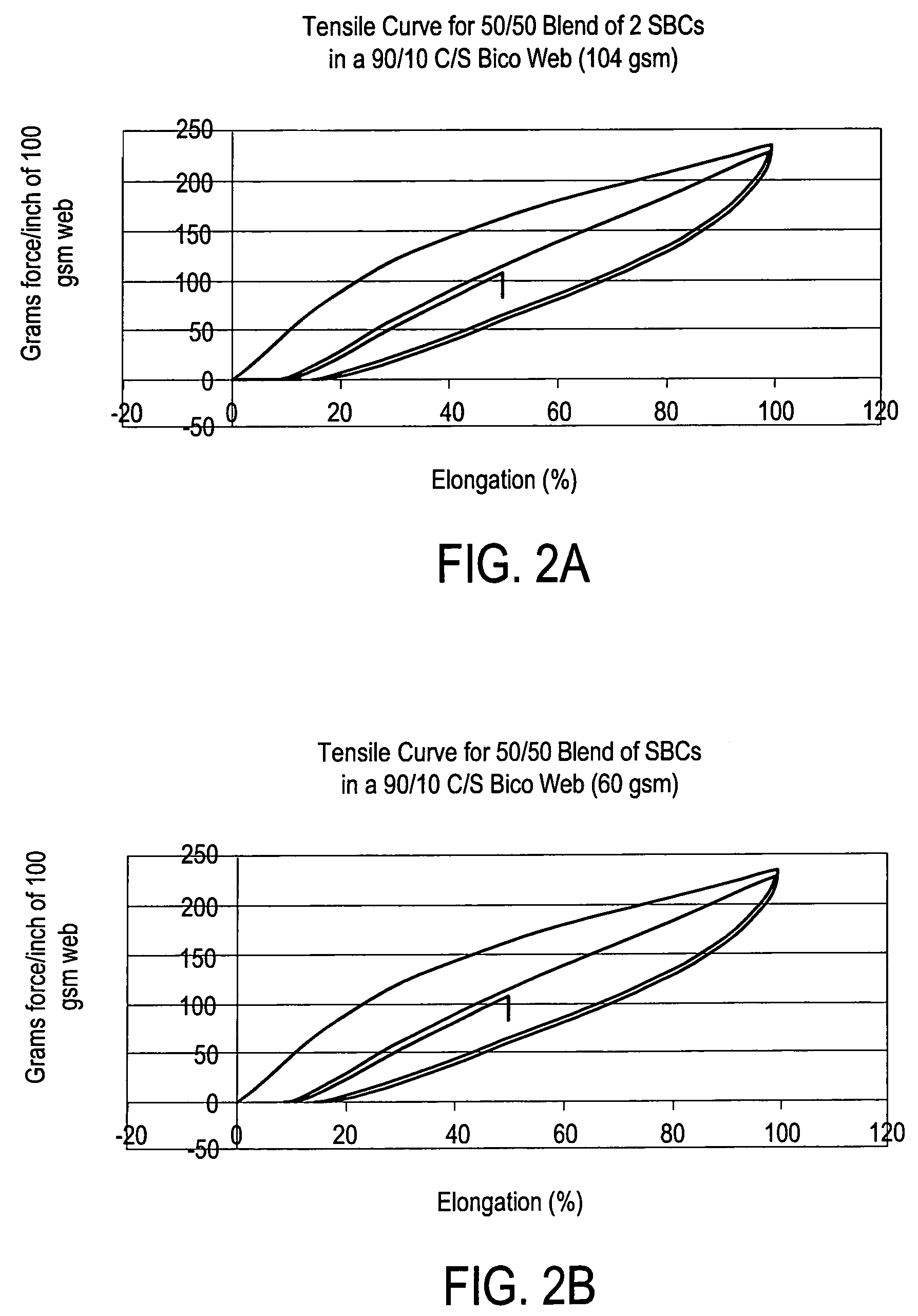Fibers made from block copolymer
a technology of fibers and copolymers, applied in the direction of yarn, transportation and packaging, synthetic resin layered products, etc., to achieve the effect of sufficient strength
- Summary
- Abstract
- Description
- Claims
- Application Information
AI Technical Summary
Benefits of technology
Problems solved by technology
Method used
Image
Examples
examples 18-22
, TABLE 1d
[0135]Materials 18 to 22 were spun as mono- or bicomponent fiber tows and were drawn with either a Lurgi-style air draw system or velocity controlled draw roll (godet). Materials 18 and 19 were commercial materials, except that the compositions were modified, and include an oil. In the compositions containing oil, the oil was added by mixing the elastomer resin pellets with the oil so that the oil would absorb into the pellets until essentially dry to the touch (e.g., 1 week at room temperature).
[0136]Material 20 is an example of a pentablock SBC showing excellent fiber tensile properties as well as good spinnability and process temperature. The fiber diameter in this example, produced at low draw velocity, is 33 microns. The polyethylene sheath used in this example had a density of approximately 0.93 g / cc. Soft sheath materials, like PE (especially of low density), seem to produce better bicomponent fibers with SBC elastomers.
[0137]Materials 21 and 22 are low Mw triblock ...
examples 23 to 35
[0139]Table 2 presents spunlaid nonwovens produced from bicomponent filaments where up to 96% of the fiber is an elastic SBC of the present invention (not presented are fabrics we have produced of 100% elastic fibers, since these fabrics have a more rubbery hand than desired). In each case the bond temperature is much below that found / required for fibers of similar construction but using non-SBC, and especially non-elastomeric components. All these fabrics are elastic with >65% recovery when extended to 50% elongation. In addition all fabrics have a soft, cloth-like hand that is unique from the individual components of the fiber. All fiber diameters are below 50 microns. Two types of bicomponent structures are shown here: core / sheath (C / S) and tipped trilobal (T / T). Three types of draw system are also shown: S-Tex, a low velocity slot method (≧500 m / min); Lurgi gun, a high velocity forced air orifice (>750 m / min); and Reicofil 3 (RF3), a high velocity slot (≧1000 m / min). Basis weigh...
examples 36 , 37 and 38
EXAMPLES 36, 37 AND 38
[0141]Examples 36, 37 and 38 were prepared on an apparatus similar to the one described above (and schematically shown in FIG. 3). However, this particular apparatus did not have a thermal bonding calendar 13. It was possible to prepare webs of sufficient strength for winding by pressing the webs against the forming wire using compaction roll 12. The filament drawing device used for these examples was similar to the device described in U.S. Pat. No. 5,225,018. The composition of the examples is given in Table 3. Pieces of the compacted webs were processed through a thermal point bonding calendar in order to determine the effect of bond temperature on fabric strength. The results are presented in FIGS. 4 to 6. The fabrics achieve their maximum tensile strengths at temperatures far below the typical bonding temperature of the polyethylene sheaths of the filaments. The recovery from 100% elongation and the stress relaxation after 5 minutes at 50% elongation for th...
PUM
| Property | Measurement | Unit |
|---|---|---|
| diameter | aaaaa | aaaaa |
| temperature | aaaaa | aaaaa |
| temperature | aaaaa | aaaaa |
Abstract
Description
Claims
Application Information
 Login to View More
Login to View More - R&D
- Intellectual Property
- Life Sciences
- Materials
- Tech Scout
- Unparalleled Data Quality
- Higher Quality Content
- 60% Fewer Hallucinations
Browse by: Latest US Patents, China's latest patents, Technical Efficacy Thesaurus, Application Domain, Technology Topic, Popular Technical Reports.
© 2025 PatSnap. All rights reserved.Legal|Privacy policy|Modern Slavery Act Transparency Statement|Sitemap|About US| Contact US: help@patsnap.com



